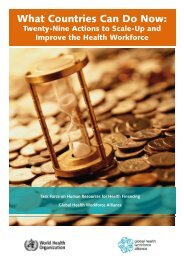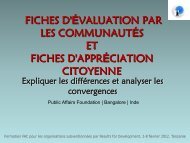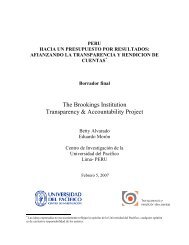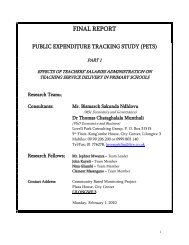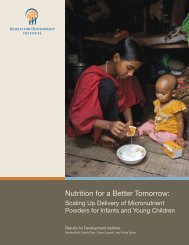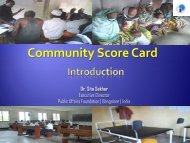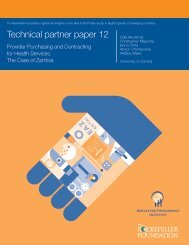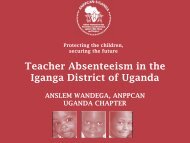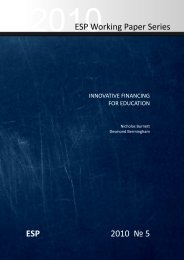Innovative Secondary Education For Skills Enhancement
Innovative Secondary Education For Skills Enhancement
Innovative Secondary Education For Skills Enhancement
You also want an ePaper? Increase the reach of your titles
YUMPU automatically turns print PDFs into web optimized ePapers that Google loves.
Section 1: <strong>Innovative</strong> Models of <strong>Secondary</strong><br />
<strong>Education</strong> In Sub-Saharan Africa 14<br />
Many countries in Sub-Saharan Africa face huge challenges<br />
as they seek to provide access to a good-quality secondary<br />
education for all students. <strong>Secondary</strong> gross enrollment<br />
rates rose to just under 40 percent in 2009–10, but there<br />
is wide variation between countries as well as between<br />
rural and urban areas within a country. There is also<br />
widespread concern in many countries in the region that<br />
increased investment has not brought returns in terms of<br />
improved learning outcomes, and even relatively wealthy<br />
countries are struggling to recruit and retain high-quality<br />
teachers. <strong>Secondary</strong> schools are limited, and selection for<br />
secondary schooling is highly competitive. The majority<br />
of poor students do not proceed to any form of secondary<br />
education, and the gap between the number of boys<br />
and girls completing secondary education remains high in<br />
almost all countries in the region.<br />
Increasingly, governments in Africa have recognized<br />
that secondary education is an important priority in the<br />
development of their education systems. Most countries<br />
have expanded their definition of basic education to<br />
include nine years—six years of primary plus three years<br />
of lower secondary—which is generally provided free of<br />
fees. However, though improvements have been made in<br />
increasing access to basic education for African students,<br />
education quality remains a critical challenge and many<br />
innovations identified in Africa (see Table 1) are geared<br />
toward improving student performance.<br />
Table 1: Summary of profiled innovations in Africa<br />
Model Key Features Country<br />
Innovations to improve existing system<br />
Improving the Quality and Relevance of Middle School<br />
in Senegal. Multi-stakeholder partnership between NGO,<br />
government, and the private sector to improve quality of<br />
curriculum and pedagogy in Senegalese secondary schools.<br />
Science Resource Centers. IT resource sharing program<br />
implemented by Ghana government to reduce inequality of<br />
resources between schools.<br />
Ghana <strong>Education</strong> Trust Fund. Government fund to support<br />
innovation in the education sector.<br />
Innovations to transform existing system<br />
Open and Distance Learning. Alternative schooling system<br />
offered by Namibia College of Open Learning and Botswana<br />
College of Open and Distance Learning.<br />
Innovations to reach excluded populations<br />
Jua Kali Voucher Program. Demand-side financing program to<br />
increase access to education for marginalized populations.<br />
Science, Technology, and Mathematics (STEM) Clinic for Girls.<br />
Provides additional support for girls to study math and science.<br />
Emusoi Center. Provides educational improvement and<br />
empowerment services to girls from Maasai communities.<br />
Innovations to provide 21st-century skills<br />
Educate! Student mentorship scheme to develop non-cognitive<br />
and entrepreneurial skills in upper secondary students in<br />
Uganda.<br />
Curriculum reform;<br />
enhancing pedagogy;<br />
multi-stakeholder approach;<br />
non-cognitive skill development<br />
<strong>Innovative</strong> use of ICT<br />
<strong>Innovative</strong> financing<br />
Alternative schooling model; targets<br />
excluded populations<br />
<strong>Innovative</strong> financing<br />
targets excluded populations;<br />
Targets excluded populations<br />
Targets excluded populations; noncognitive<br />
skill development<br />
Non-cognitive skill development;<br />
multi-stakeholder approach<br />
Senegal<br />
Ghana<br />
Ghana<br />
Namibia; Botswana<br />
Kenya<br />
Ghana<br />
Tanzania<br />
Uganda<br />
14 This section draws heavily on Appiah and Anarfi (2012).<br />
38 <strong>Innovative</strong> <strong>Secondary</strong> <strong>Education</strong> <strong>For</strong> <strong>Skills</strong> <strong>Enhancement</strong> (ISESE)



